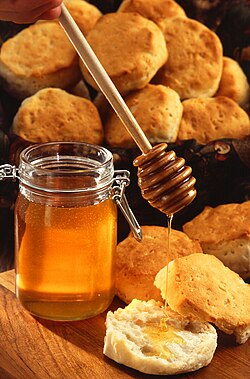Honey
Is used in some cosmetics as an emollient. If one is allergicto pollen, honey may cause a problem. It is, otherwise, non-toxic.
Honey is a sweet and viscous substance made by several bees, the best-known of which are honey bees. Honey is made and stored to nourish bee colonies. Bees produce honey by gathering and then refining the sugary secretions of plants (primarily floral nectar) or the secretions of other insects, like the honeydew of aphids. This refinement takes place both within individual bees, through regurgitation and enzymatic activity, as well as during storage in the hive, through water evaporation that concentrates the honey's sugars until it is thick and viscous.
Honey bees stockpile honey in the hive. Within the hive is a structure made from wax called honeycomb. The honeycomb is made up of hundreds or thousands of hexagonal cells, into which the bees regurgitate honey for storage. Other honey-producing species of bee store the substance in different structures, such as the pots made of wax and resin used by the stingless bee.
Honey for human consumption is collected from wild bee colonies, or from the hives of domesticated bees. The honey produced by honey bees is the most familiar to humans, thanks to its worldwide commercial production and availability. The husbandry of bees is known as beekeeping or apiculture, with the cultivation of stingless bees usually referred to as meliponiculture.
Honey is sweet because of its high concentrations of the monosaccharides fructose and glucose. It has about the same relative sweetness as sucrose (table sugar). One standard tablespoon (15 mL) of honey provides around 190 kilojoules (46 kilocalories) of food energy. It has attractive chemical properties for baking and a distinctive flavor when used as a sweetener. Most microorganisms cannot grow in honey and sealed honey therefore does not spoil. Samples of honey discovered in archaeological contexts have proven edible even after thousands of years.
Honey use and production has a long and varied history, with its beginnings in prehistoric times. Several cave paintings in Cuevas de la Araña in Spain depict humans foraging for honey at least 8,000 years ago. While Apis melifera is an Old World insect, large-scale meliponiculture of New World stingless bees has been practiced by Mayans since pre-Columbian times.











